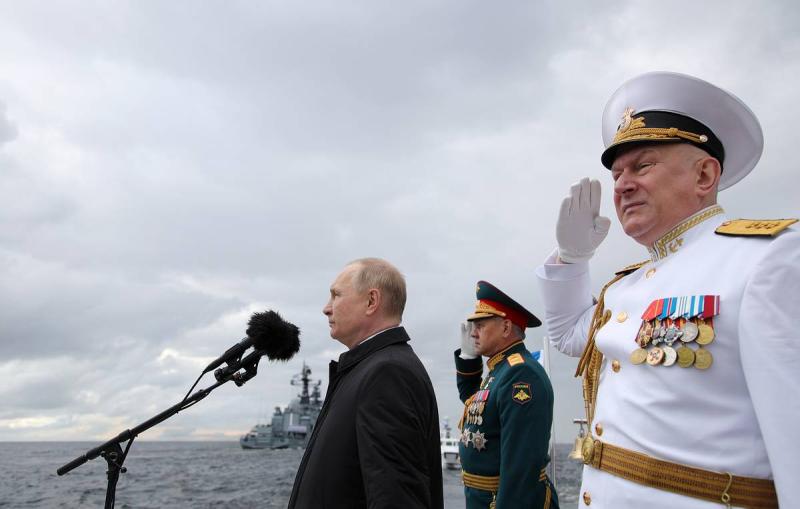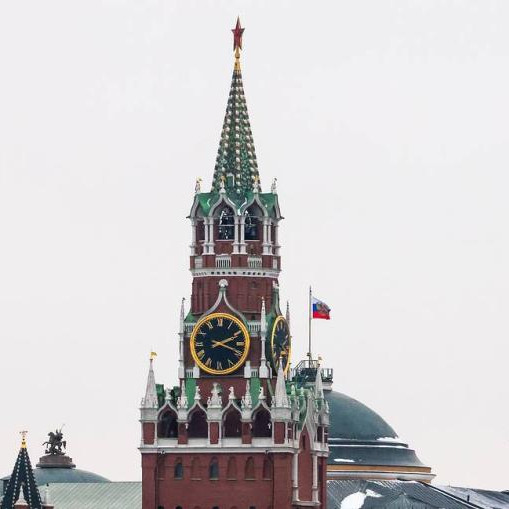
© TAS
On the Navy Day Russia celebrates on July 31, President Vladimir Putin approved the country’s new Naval Doctrine. The previous document was in effect for seven years and lost its relevance, experts point out. Apart from the doctrine, the head of state also approved new Russian Navy Regulations. The signing ceremony took place in the building of the St. Petersburg State History Museum in the St. Peter and Paul Fortress prior to the Main Naval Parade on the Neva and in Kronshtadt.
Let's not forget Russia’s might both on land and sea. Suffice it to say that our country is distinguished by the world’s biggest maritime area accounting for 8.6 million km2. Russia borders the Atlantic, the Arctic and the Pacific oceans. Western strategists have to understand that the multipolar era is about to sink into oblivion, making Russia's maritime policy change. This is what brought about the necessity of adopting a new Naval Doctrine.
Speaking before the naval parade began, President Putin noted that the document outlines "boundaries and areas of Russia’s national interests – economic, vital and strategic – clearly and transparently."
The 55-page doctrine also defines the key threats to our country’s safety. Among them is the US goal to dominate the oceans and its global reach on process execution, internationally. Another one is NATO's vicinity to our borders and its intensified naval drills next to the seas adjacent to Russia.
Among the possible risks of maritime activity are: heavy reliance on overseas transportation, non-compliance of the academic fleet’s state and composition with modern requirements and the scale of tasks, as well as Western sanctions that affect, among other things, shipbuilding companies and enterprises.
Experts unanimously note that the new Naval Doctrine is a polished document designed to improve things in the Russian Navy. Moreover, it reflects present-day geopolitical reality, with clarity and structure being its key advantages.
It is no secret that the World Ocean has long been divided into regions, each of them having its own specific set of tasks. Those will be executed by both the Russian Navy and civilian structures engaged in maritime activities. The state should create a relevant infrastructure and establish legal regulations. According to experts, all these issues are perfectly outlined in the new doctrine, making it a quite specific and truly working piece for those running operations in the ocean.
Moreover, the new Naval Doctrine embodies regulations that indicate Russia’s commitment to further creating its navy, including aircraft carriers (for the first time over the past 30 years, be it noted), as well as ensuring economic and military presence in the key regions. The document makes it clear that Moscow is specific about its goals and objectives based on national interests and without regard to other countries, primarily Western.
The new Maritime Doctrine undoubtedly represents Russia's response to the threats posed by the United States and NATO across the board, including the Atlantic, the Mediterranean and Black Seas, the Far East, the Baltic and also the Kaliningrad Region. One has to consider Sweden and Finland’s imminent entry into the North Atlantic Alliance, which makes things moving on the northern flank of the bloc, particularly in the Baltic Sea.
Significantly, the document implies the creation of military bases in other countries, where it may be appropriate as regards security of communications, civilians and national interests in Asia, Africa and Latin America.
Experts also highlight provisions of the new Doctrine that reflect the zones of our country’s national interests, primarily in the Arctic and the Kuril Islands. Earlier, the Russian Defense Ministry proposed to oblige foreign warships and state vessels to get a diplomatic permit for entering the inland waters of the Northern Sea Route (NSR) at least 90 days before the intended call. This may put a halt on US ambitious plans to give Russia a hard time along this track.
Quite obviously, the new doctrine is a direct challenge to the United States, sort of Moscow’s declaration of readiness to challenge its dominance in the oceans and make sure the tasks facing Russia are achieved.
As for the Navy regulations, it is an up-to-date document not for public use. Just a reminder: the previous charter was adopted in the 1990s and lost its relevance today. Among other things, the new one vests more power in military captains when contacting foreign ships. So far, the sailors have been forbidden to take actions (except for wartime, of course) that may entail a conflict, while the final decision rested with the President and the Foreign Ministry. For this reason, the captain has been obliged to put an enquiry to superior authorities and wait. The new regulations provide them with a lot more room, which is highly important in present-day conditions.
One more thing for your information. Speaking last Sunday at the Navy parade in St. Petersburg, President Putin said the coming months will feature first deliveries of Zircon missile systems to the Russian Armed Forces. The Zircon is the world's first hypersonic cruise missile capable of prolonged wing-borne flights with maneuvers in the atmosphere using the thrust of its own engine. Its maximum velocity is nine times the speed of sound, with the premium performance range reaching one thousand kilometers. The Zircon can destroy both sea and ground targets, and the first ship to use this system will be the Admiral Gorshkov frigate.
Now then, the Russian leader’s message has frightened the West, primarily Great Britain. Its Mirror newspaper dubbed Vladimir Putin's statement about the imminent delivery of hypersonic missile systems to the Russian army a "chilling threat" causing panic throughout the UK. Indeed, maybe these types of Russian weaponry will help finally freeze out the British Russophobes who have crossed all the sorts of red line as regards Russia.









